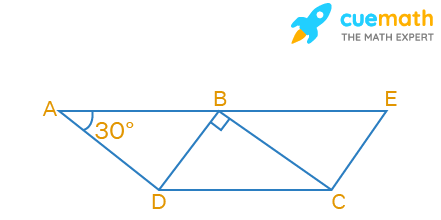In the given figure, ABCD and BDCE are parallelograms with common base DC. If BC ⊥ BD, then ∠BEC =
(a) 60°
(b) 30°
(c) 150°
(d) 120°

Solution:
Given, ABCD and BDCE are parallelograms with common base DC.
BC ⊥ BD
We have to find the measure of ∠BEC.
From the figure,
∠BAD = 30°
We know that the opposite angles in a parallelogram are equal.
So, ∠BCD = 30°
Considering triangle CBD,
By angle sum property of a triangle, the sum of all three interior angles of a triangle is equal to 180 degrees.
We know that the opposite angles in a parallelogram are equal.
∠DBC + ∠BCD + ∠BDC = 180°
90° + 30° + ∠BDC = 180°
120° + ∠BDC = 180°
∠BDC = 180° - 120°
∠BDC = 60°
We know that the opposite angles in a parallelogram are equal.
So, ∠BEC = 60°
Therefore, the required angle is 60°.
✦ Try This: In a parallelogram, if one of the angle is 40°, then other three angles are
☛ Also Check: NCERT Solutions for Class 8 Maths
NCERT Exemplar Class 8 Maths Chapter 5 Problem 35
In the given figure, ABCD and BDCE are parallelograms with common base DC. If BC ⊥ BD, then ∠BEC = (a) 60° (b) 30° (c) 150° (d) 120°
Summary:
In the given figure, ABCD and BDCE are parallelograms with common base DC. If BC ⊥ BD, then ∠BEC = 60°.
☛ Related Questions:
- Length of one of the diagonals of a rectangle whose sides are 10 cm and 24 cm is (a) 25 cm (b) 20 cm . . . .
- If the adjacent angles of a parallelogram are equal, then the parallelogram is a (a) rectangle (b) t . . . .
- Which of the following can be four interior angles of a quadrilateral? (a) 140°, 40°, 20°, 160° (b) . . . .
visual curriculum
